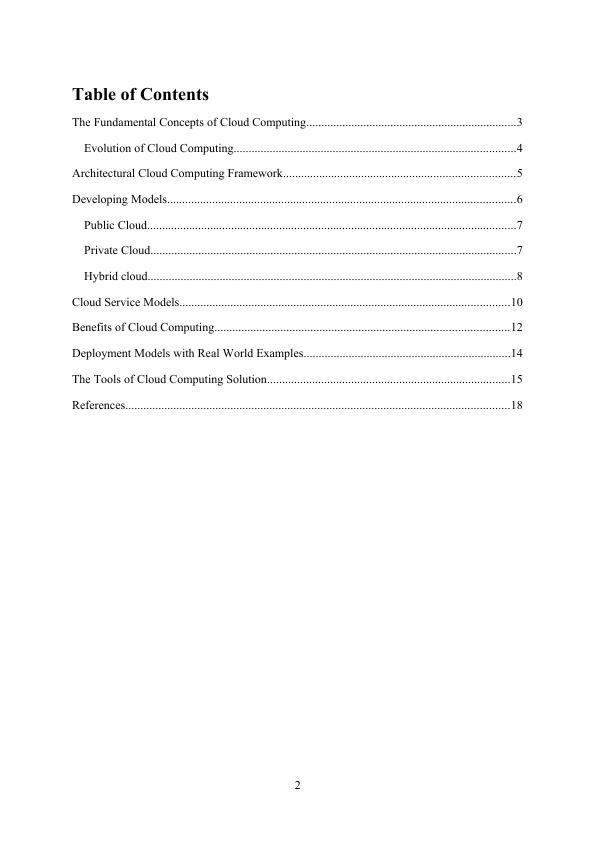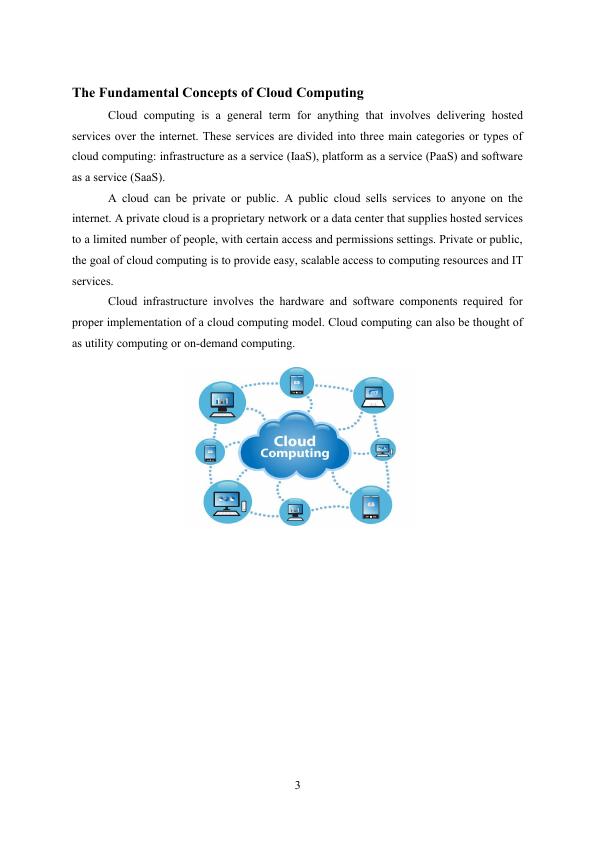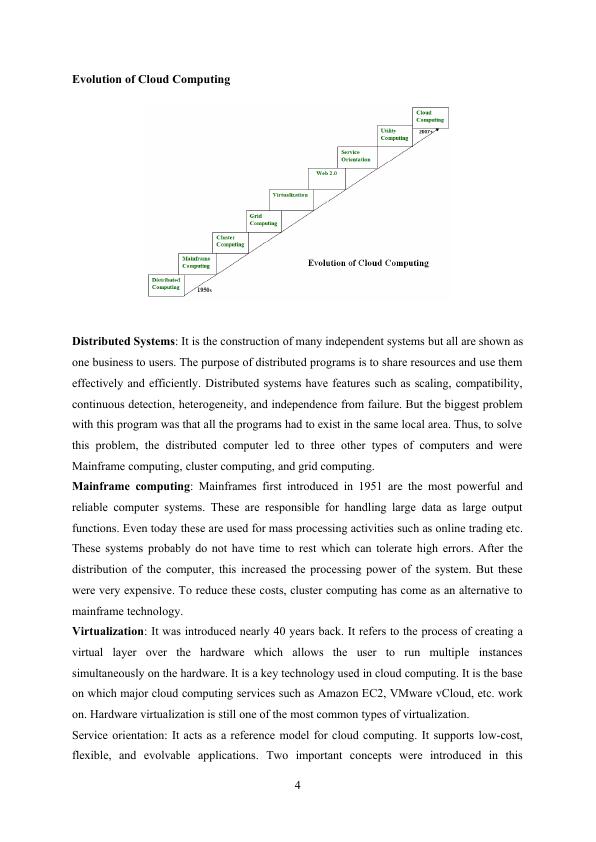Cloud Computing and Usage of Development Models
Added on 2022-03-17
18 Pages4818 Words63 Views
1
Unit 16 – Cloud Computing
Assignment 1 : Cloud Computing and Usage of
Cloud Deloyment Models
Hsu Wai Wai Hlaing
11th Batch
Youth International University
Unit 16 – Cloud Computing
Assignment 1 : Cloud Computing and Usage of
Cloud Deloyment Models
Hsu Wai Wai Hlaing
11th Batch
Youth International University

Table of Contents
The Fundamental Concepts of Cloud Computing......................................................................3
Evolution of Cloud Computing..............................................................................................4
Architectural Cloud Computing Framework.............................................................................5
Developing Models....................................................................................................................6
Public Cloud...........................................................................................................................7
Private Cloud..........................................................................................................................7
Hybrid cloud...........................................................................................................................8
Cloud Service Models..............................................................................................................10
Benefits of Cloud Computing..................................................................................................12
Deployment Models with Real World Examples.....................................................................14
The Tools of Cloud Computing Solution.................................................................................15
References................................................................................................................................18
2
The Fundamental Concepts of Cloud Computing......................................................................3
Evolution of Cloud Computing..............................................................................................4
Architectural Cloud Computing Framework.............................................................................5
Developing Models....................................................................................................................6
Public Cloud...........................................................................................................................7
Private Cloud..........................................................................................................................7
Hybrid cloud...........................................................................................................................8
Cloud Service Models..............................................................................................................10
Benefits of Cloud Computing..................................................................................................12
Deployment Models with Real World Examples.....................................................................14
The Tools of Cloud Computing Solution.................................................................................15
References................................................................................................................................18
2

The Fundamental Concepts of Cloud Computing
Cloud computing is a general term for anything that involves delivering hosted
services over the internet. These services are divided into three main categories or types of
cloud computing: infrastructure as a service (IaaS), platform as a service (PaaS) and software
as a service (SaaS).
A cloud can be private or public. A public cloud sells services to anyone on the
internet. A private cloud is a proprietary network or a data center that supplies hosted services
to a limited number of people, with certain access and permissions settings. Private or public,
the goal of cloud computing is to provide easy, scalable access to computing resources and IT
services.
Cloud infrastructure involves the hardware and software components required for
proper implementation of a cloud computing model. Cloud computing can also be thought of
as utility computing or on-demand computing.
3
Cloud computing is a general term for anything that involves delivering hosted
services over the internet. These services are divided into three main categories or types of
cloud computing: infrastructure as a service (IaaS), platform as a service (PaaS) and software
as a service (SaaS).
A cloud can be private or public. A public cloud sells services to anyone on the
internet. A private cloud is a proprietary network or a data center that supplies hosted services
to a limited number of people, with certain access and permissions settings. Private or public,
the goal of cloud computing is to provide easy, scalable access to computing resources and IT
services.
Cloud infrastructure involves the hardware and software components required for
proper implementation of a cloud computing model. Cloud computing can also be thought of
as utility computing or on-demand computing.
3

Evolution of Cloud Computing
Distributed Systems: It is the construction of many independent systems but all are shown as
one business to users. The purpose of distributed programs is to share resources and use them
effectively and efficiently. Distributed systems have features such as scaling, compatibility,
continuous detection, heterogeneity, and independence from failure. But the biggest problem
with this program was that all the programs had to exist in the same local area. Thus, to solve
this problem, the distributed computer led to three other types of computers and were
Mainframe computing, cluster computing, and grid computing.
Mainframe computing: Mainframes first introduced in 1951 are the most powerful and
reliable computer systems. These are responsible for handling large data as large output
functions. Even today these are used for mass processing activities such as online trading etc.
These systems probably do not have time to rest which can tolerate high errors. After the
distribution of the computer, this increased the processing power of the system. But these
were very expensive. To reduce these costs, cluster computing has come as an alternative to
mainframe technology.
Virtualization: It was introduced nearly 40 years back. It refers to the process of creating a
virtual layer over the hardware which allows the user to run multiple instances
simultaneously on the hardware. It is a key technology used in cloud computing. It is the base
on which major cloud computing services such as Amazon EC2, VMware vCloud, etc. work
on. Hardware virtualization is still one of the most common types of virtualization.
Service orientation: It acts as a reference model for cloud computing. It supports low-cost,
flexible, and evolvable applications. Two important concepts were introduced in this
4
Distributed Systems: It is the construction of many independent systems but all are shown as
one business to users. The purpose of distributed programs is to share resources and use them
effectively and efficiently. Distributed systems have features such as scaling, compatibility,
continuous detection, heterogeneity, and independence from failure. But the biggest problem
with this program was that all the programs had to exist in the same local area. Thus, to solve
this problem, the distributed computer led to three other types of computers and were
Mainframe computing, cluster computing, and grid computing.
Mainframe computing: Mainframes first introduced in 1951 are the most powerful and
reliable computer systems. These are responsible for handling large data as large output
functions. Even today these are used for mass processing activities such as online trading etc.
These systems probably do not have time to rest which can tolerate high errors. After the
distribution of the computer, this increased the processing power of the system. But these
were very expensive. To reduce these costs, cluster computing has come as an alternative to
mainframe technology.
Virtualization: It was introduced nearly 40 years back. It refers to the process of creating a
virtual layer over the hardware which allows the user to run multiple instances
simultaneously on the hardware. It is a key technology used in cloud computing. It is the base
on which major cloud computing services such as Amazon EC2, VMware vCloud, etc. work
on. Hardware virtualization is still one of the most common types of virtualization.
Service orientation: It acts as a reference model for cloud computing. It supports low-cost,
flexible, and evolvable applications. Two important concepts were introduced in this
4

End of preview
Want to access all the pages? Upload your documents or become a member.
Related Documents
Cloud Computing: Types, Advantages and Disadvantageslg...
|8
|1314
|485
Digital Marketing | Assignment Samplelg...
|9
|1751
|90
Cloud Computinglg...
|10
|2280
|86
Cloud Computing Security PDFlg...
|13
|3038
|39
Issues of Cloud Computing and Research Opportunitieslg...
|8
|2180
|443
Management Information Systemslg...
|13
|3545
|477
